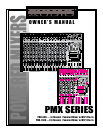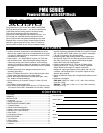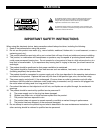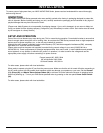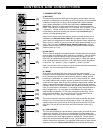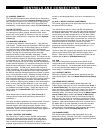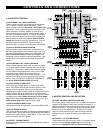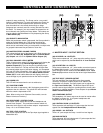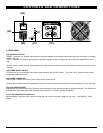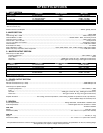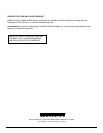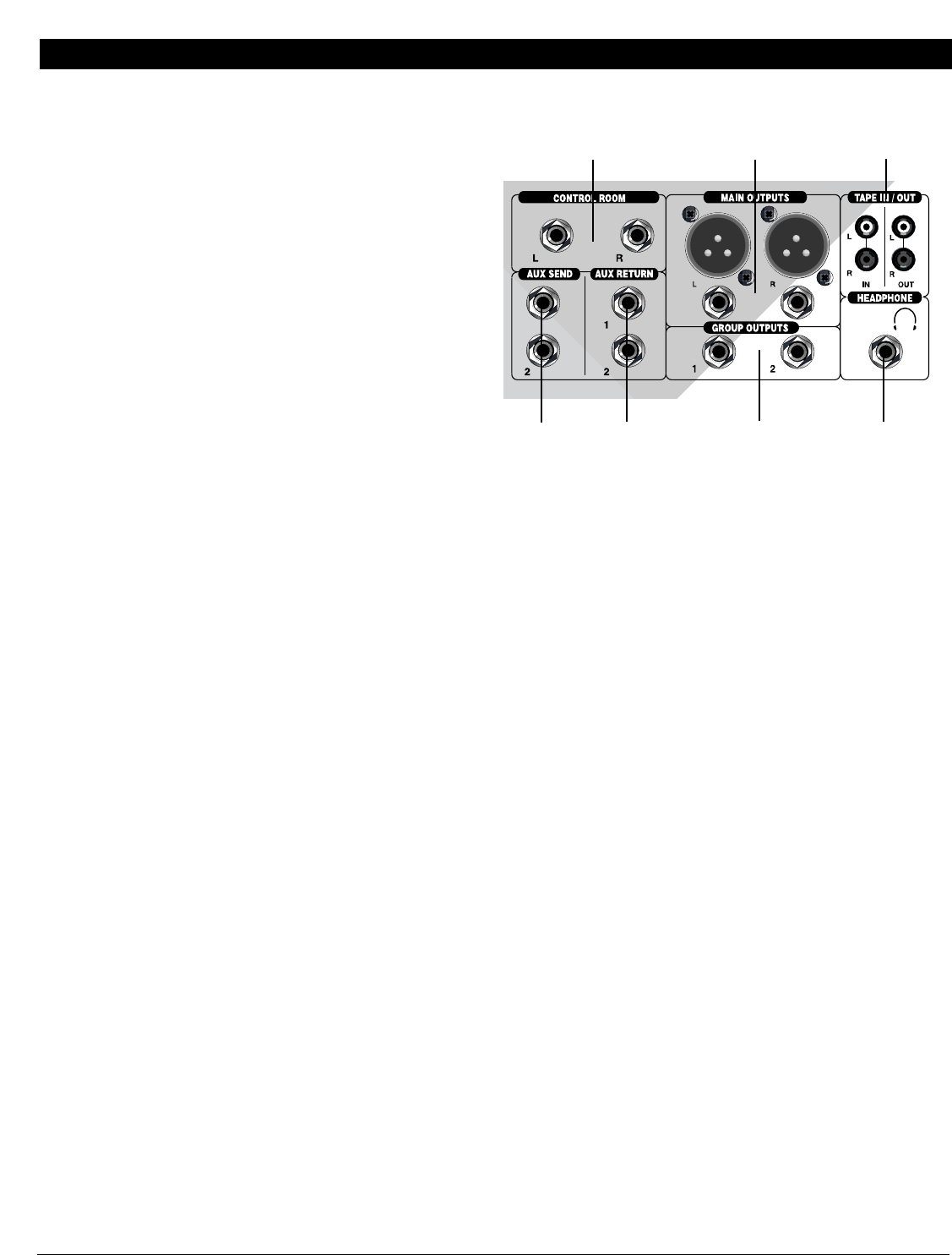
CONTROLS AND CONNECTIONS
8
4. MASTER INPUT / OUTPUT SECTION
(30) AUX SEND 1 & 2 OUTPUTS
These mono unbalanced 1/4” jacks output the auxiliary signals
which can be adjusted by the Aux Send 1 & 2 Level Controls
(14).
(31) AUX RETURN 1 & 2 INPUTS
These mono unbalanced 1/4” jacks enable convenient inputs to
the Master/Main busses. If you connect a signal to the return
jacks, the signal will be routed to the Aux Return 1 or 2 Level
Controls (16) and then mixed into the left and right Master/Main
bus.
(32) TAPE INPUT / RECORD OUTPUT
The Left and Right Tape Input RCA jacks allow cassette
recorders, CD players, or MP3 players to be added to the
Master/Main mix outputs. The input signals can be adjusted by
the Tape Level Control (29). The Record Output RCA jacks
provide a stereo signal output to recording devices, home audio
equipment, or external amplifiers. These outputs are post Master
Stereo Volume Faders (24).
(33) HEADPHONE OUTPUT
The Headphone 1/4” stereo output can be used to monitor either
the Master or Group mix. It will power headphones with
impedances of 8Ω or greater.
(34) CONTROL ROOM L-R OUTPUTS
These separate Left and Right 1/4” jacks output the line level
signals from the Headphone/Control Room (28).
(35) GROUP 1 & 2 OUTPUTS
These 1/4” jacks output the Group 1 and 2 line level signals.
(36) MAIN OUTPUTS
These balanced XLR and unbalanced 1/4” jacks output the final
Master/Main Mix line level signals.
(30)
(31)
(32)
(33)
(34)
(35)
(36)
outputs for easy monitoring. The Group can be a very useful
feature if used effectively. For stage applications the Group mix
can be sent to a monitor amplifier so the performers will only
hear the audio that is not already loud enough on stage.
Subgroups are commonly used as a mixing aid both live and in
the studio. For example, you can combine the outputs from all
drum channels onto just the two Group faders. This submix can
also be added to the Main/Master mix by depressing the Group
to Main Switch (23).
(23) GROUP TO MAIN SWITCH
When this push-button switch is depressed, the Group submix is
added to the Main/Master bus. This allows controlling the
combined volume of multiple channels with only two faders,
which can be useful when mixing a vocal quartet or multiple mics
for grouped instruments like percussion or drum kits.
(24) MASTER STEREO VOLUME FADERS
This adjusts the final level of the Master Left & Right signals, that
are sent to the Main (36), Headphone (33), and Control Room
(34) Outputs and also to the Speaker Stereo Outputs (37).
(25) DUAL CHANNEL LED VU METER
These 10-stage stereo output LED meter displays will display the
relative output level of the Left and Right Main (36) and
Speaker Outputs (37). They can be used to maintain proper
levels in the master mix. The top red Peak LED will light when
the powered output signal is just below clipping. It is acceptable
if the red LED lights occasionally. If the red LED lights more than
occasionally, you should turn down the Master Stereo Volume
Faders (24) to avoid audible distortion and clipping, which can
cause damage to your speakers and even the internal amplifier.
(26) POWER LED
This LED will illuminate when the unit is switched on.
(27) PHANTOM POWER
When this switch is depressed, +48V of phantom power will be
supplied to the mic channels. The yellow LED will illuminate
when the switch is depressed to ON.
[Note: When turning on the Phantom Power switch, turn the
Master Volumes to minimum.]
(28) HEADPHONE / CONTROL ROOM
The volume control adjusts the level of the Headphone and
Control Room Outputs. The push-button selector switch will
determine which signal is sent to these outputs - depressed for
Group 1 & 2, out for Master Stereo.
(29) TAPE LEVEL CONTROL
This control adjusts the level of the Tape Input signal applied to
Master/Main bus.



